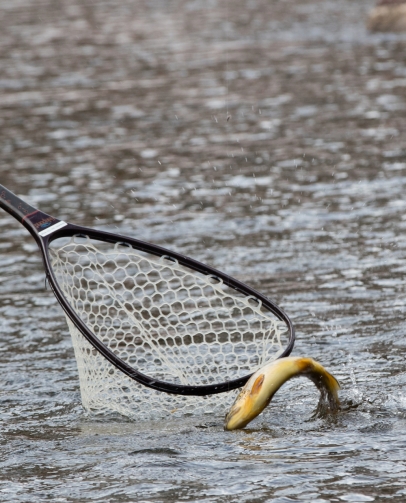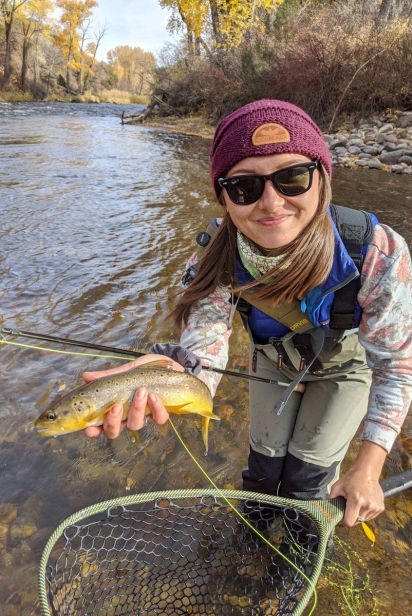Catch and Eat
“No harvest of the resource means better resource.”
That’s the common perception, anyway, among a large contingent of fishermen and -women who abide by a strict catch-and-release fishing philosophy, says Colorado Parks and Wildlife District Wildlife Manager Matt Yamashita.
“Those historic norms of ‘We’ve got to save as many fish as possible in order to promote a trophy fishery’—that still resonates very strongly within most of our population in the valley,” Yamashita says.
But on the Gold Medal waters of the Fryingpan River above Basalt, saving as many fish as possible isn’t actually the goal for CPW. Current regulations say it’s not only lawful to harvest brown trout from the Fryingpan, but encouraged.
There are limits to the rule—you can only take two, and they must be less than 14 inches long—but the message is out there for hungry anglers, says CPW Aquatic Ecologist Kendall Bakich: “If you enjoy eating fish, the Fryingpan is a great place to go to harvest brown trout.”
The trout are “delicious,” she says, but the message is driven by ecological and social factors rather than flavor.
According to Bakich, the brown trout population is so dense that it’s affecting other species’ ability to thrive; that’s a particular concern for rainbow trout, which managers are now trying to reestablish after whirling disease tanked the population. (“Highly aggressive” brown trout, which were already resistant to whirling disease, are both a competitor and a predator of rainbow trout.) Plus, a population that’s too dense can stunt the growth of individual fish, which can affect the fishing experience anglers want, Bakich says.
Studies on the Gunnison and Cache la Poudre rivers several years back, along with a more recent study on the Yampa River, have helped wildlife managers understand how removing brown trout could help reestablish rainbow trout populations, at least in the short term.
But it’d be “very difficult” to remove all brown trout, Bakich says, and “maybe not something that’s socially tolerable everywhere.” Species-specific catch-and-harvest policies like on the Fryingpan can give rainbow trout “a leg up.” One fish survey site just below Ruedi Reservoir recorded 1,346 brown trout in an acre in 2019, compared to just 63 rainbow trout; Bakich says a “good” and “achievable” density for brown trout would be 700 fish per acre, but even 200 per acre is “fairly dense.”
Though harvesting brown trout is a rare allowance in the otherwise catch-and-release Fryingpan River, fishing regulations are more harvest-friendly in other Gold Medal waterways, like a long stretch of the Roaring Fork River between Woody Creek and the Colorado River. As Bakich notes, harvesting has long been the default, not the exception to the rule.
“All these fisheries were established at a time when harvest was the norm,” Bakich says. “Catch-and-release regulations would go in from time to time when all other tools failed.”
CPW officials say the Fryingpan’s brown trout harvest allowance can come as a surprise to some people. Yamashita attributes that in part to the “nebulous” concept of conservation.
“I don’t think that’s 100 percent accurate that conservation equates to ‘catch and release’ or to no harvest of the resource,” Yamashita says. “Conservation in certain regards doesn’t mean just protection of the resource; it also means there’s a way to utilize that resource that is beneficial for the resource itself.”
Avid local fisherwoman Ali Hager Hammond also makes a distinction between preservation and conservation, something she knows about as the community wildfire resilience director for the Aspen Fire Protection District and a former naturalist with Aspen Center for Environmental Studies (ACES).
“Preservation is this idea that things need to be the same and not touched,” Hammond says. “Conservation is the idea that no matter what, we’re going to have an impact on our surroundings, and so we need to take a more active role in managing our surroundings.”
She’s been fishing—and eating fish—for nearly her entire life, an experience that she says “almost feels like getting back to the roots of being a human.”
Hammond sees the ecological benefit, too.
“Putting something back—there’s a nice element of ‘leave no trace’ to that mentality,” she says. “But at the same time, knowing that you are having an impact no matter what you do, whether you put that fish back or not … When we talk about the larger picture of overall health, sometimes things like hunting and fishing can actually help more appropriately manage species in ways that give ecosystems more resilience.”
How to Prepare Trout
When she was growing up fishing and eating rainbow trout in the Sierras, Hammond says, her family would gut the fish, fill it with butter and garlic, place it in a foil pouch, and cook the pouch over an open fire.
“When the eyeballs get white and start popping out, you know they’re done,” she says.
But for brown trout at its best, Hammond recommends breaking out the deep fryer.
“That is my absolute preferred method of eating brown trout, especially if you can add that extra layer of breading it and then frying it,” she says. “It’s phenomenal.”






